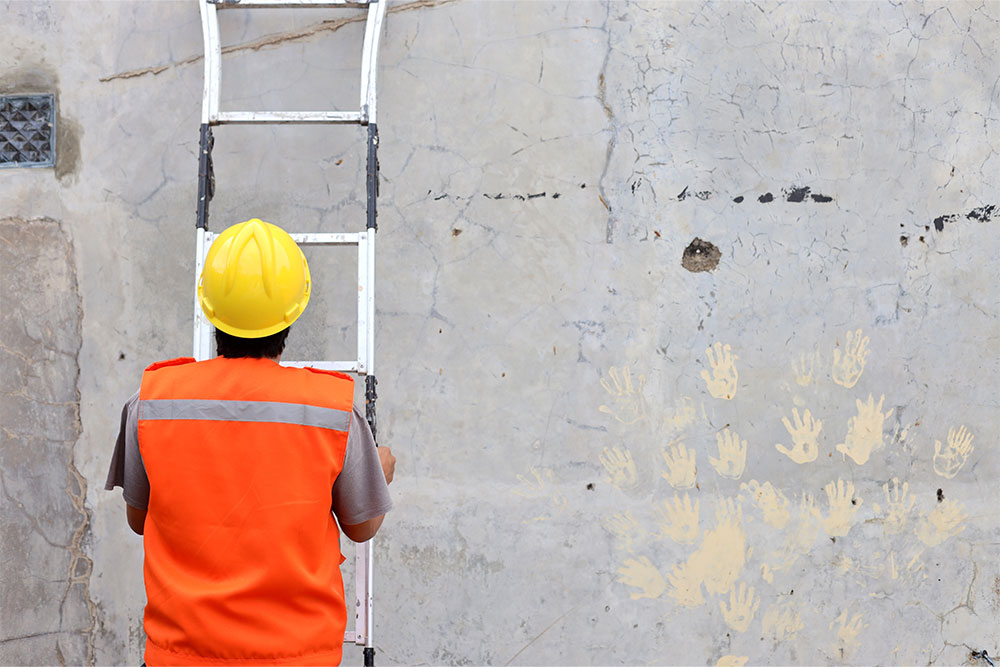
What size ladder do you need for a two-storey house? Whatever size lets you work safely. A ladder that reaches around 7 metres (23 feet) is typical. But there’s no single answer – you need to make the final decision based on the house, work and conditions.
This guide explains how to select the right-sized ladder for any task. It also covers the regulations and rules you must follow if you’re a tradesperson or using a ladder for paid work.
Ladder Safety Regulations
Ladder work must comply with the Work at Height Regulations 2005 (WAH). (Private homeowners don’t need to comply but will benefit from following its recommendations for safe working.)
Under the WAH Regulations, any work involving ladders must be properly planned, supervised and carried out safely.
Before any ladder work can begin, someone competent must have assessed the risks and planned how to make it safe. One of the most critical decisions is using the right equipment. So, knowing what size ladder you need for a two-storey house is a legal duty for tradespeople.
What Size Ladder Do You Need for a Two-Storey House?
There’s no rule on what size ladder you need for a two-storey house.
However, the general advice is to use an extension ladder that reaches 7 metres (23 feet). This size ladder should be safe for work on the average two-storey house, which is between 5.5 to 6.5 metres (18 to 21 feet) in the UK.
This recommendation is not a hard rule. There will be situations when a 7-metre ladder is not safe because of the task or house. So, before committing to a 7-metre ladder, someone competent must have confirmed it’s the safest option for the planned work.
The Health and Safety Executive (HSE) expects competent people to make final decisions on many workplace safety issues because a one-size-fits-all approach is impractical. All work is different; it would be impossible to produce a fixed set of rules for making it safe.
Instead, a competent person (someone with the necessary knowledge, skills, experience and training) should review the relevant regulations and apply them to their work. We’ve outlined what this means for ladder sizing below.
Choosing the Right Ladder Size
When choosing a ladder, it’s essential to follow HSE guidelines. The HSE outlines how to choose the right-sized ladder in Safe Use of Ladders and Stepladders: A Brief Guide.
We’ve summarised the key points below:
- Suitable for the Task: Choose an appropriate ladder for the job. Different types of ladders serve different purposes:
- Extension Ladders: Ideal for reaching higher points but can be heavy and difficult to transport.
- Telescopic Ladders: Easy to store and transport. Adjustable to various heights but generally less durable than extension ladders.
- Combination Ladders: Versatile but more complicated to set up and maintain.
- Roof Ladders: Designed for work on pitched roofs. They hook over the roof ridge for stability but are unsafe for other types of work.
- Step Ladders: Provide a stable platform for tasks at low heights but limited in reach compared to other types of ladders.
- The Ladder Must Extend Higher Than the Work Area: Ensure the ladder extends at least three rungs (approximately 1 metre) above the highest point you need to reach.
This extra height gives you a secure handhold and helps stability, which is why a 7-metre ladder is recommended for work on a 5.5-metre house. If in doubt, bigger is better. Don’t risk working from the very top of any ladder.
- Follow the 1-in-4 Rule: When positioning a leaning ladder, use the 1-in-4 rule for stability. Place the base of the ladder 1 unit away from the wall for every 4 units of height. Remember this rule when weighing up ladder sizes.
- Set Up Safely: Ladders must be placed on firm, level ground and secured to prevent slipping. Leaning ladders must also rest against a stable surface. Avoid resting them against plastic gutters or glazing, and use a stand-off device if necessary.

Ladder Safety Tips
Under the WAH Regulations, you must be competent (or supervised by someone competent) to use a ladder. Although competence takes training and experience, there are ladder safety tips you must be aware of:
- Pre-Use Checks: Check your ladder at the start of each workday. A competent person must look for signs of wear or damage. Take any ladder that fails out of service immediately.
- Regular Inspections: Carry out more detailed inspections occasionally. A competent person should conduct and record more detailed inspections as needed. Again, there are no set rules for inspection frequency (a competent person should have the final say), but general recommendations are:
- Ladders used daily should be inspected every three months.
- Ladders used weekly should be inspected every six months.
- Ladders used monthly should be inspected every year.
- Maintain Three Points of Contact: Always keep three points of contact (two hands and one foot, or two feet and one hand) while on a ladder. For quick tasks where you need both hands, you can keep two feet on the ladder while leaning your body against it for stability.
- Respect Weight Limits: Overloading a ladder can cause it to become unstable. Consider the combined weight of the user, as well as the tools and materials, when determining if the ladder can safely support the load.
- Keep Your Body Between the Stiles: Avoid leaning too far to the sides or overreaching to prevent tipping. As a general rule, keep your belt buckle (or navel) between the stiles at all times.
What Size Ladder Do You Need for a Two-Storey House? – Key Takeaways
- A ladder that extends around 7 metres (23 feet) is typically suitable for a two-storey house.
- Always ensure the ladder extends at least three rungs (approximately 1 metre) above the work area.
- Follow the 1-in-4 rule for ladder positioning: the base should be 1 unit away from the wall for every 4 units of height.
- Competence in choosing, using and inspecting ladders is a legal requirement under the Work at Height Regulations.
- Regular ladder inspections are essential for safety.
Ladder Inspection Training
Ladder safety should be a significant concern for tradespeople. And ensuring ladder safety starts on the ground with detailed, regular inspections, as required by the WAH Regulations.
Our online Ladder Inspection Training course provides the essential skills and knowledge required to inspect ladders effectively. It covers inspection procedures for different types of ladders so you can be sure they’re safe and compliant with regulations.























































































































































































































































































































































































































































































































































































































































































































































